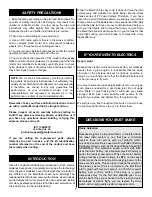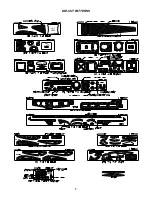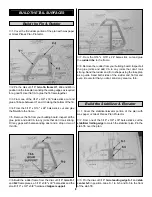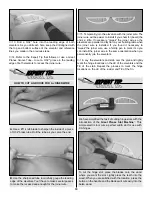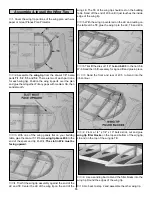
4
Items in parentheses (GPMQ4243) are suggested part
numbers recognized by most distributors and hobby shops
and are listed for your ordering convenience. GPM is the
Great Planes brand, TOP is the Top Flite
®
brand, HCA is the
Hobbico
®
brand and COV is the Coverite
™
brand.
❏
4 Channel radio with 4 mini servos
❏
(2) 2" Ultralight Wheels (GPMQ4201)
❏
(1) 3/4" Tail wheel (GPMQ4240)
❏
(4) 1/8" Wheel collars (GPMQ4304)
❏
(1) 1/16" Wheel collar (GPMQ4300)
❏
(1 Roll) Double-Sided Foam Tape (GPMQ4440)
❏
(1) 1/6 Scale Pilot
❏
(2) Rolls covering film
❏
Motor battery pack charger 900 AC/DC Charger (HCAP0125)
or 925 AC/DC Peak Detection Charger (HCAP0198)
❏
1700mAh 8.4 volt NiCd battery pack (DTXC2071) or
2000mAh 8.4 volt NiCd battery pack (DTXC2076)
Required Accessories
PREPARATIONS
Chargers
A fully charged battery pack will provide an initial “surge”
of power during the first 15 to 30 seconds of the motor
run. Then the power output stays fairly steady for the next
several minutes before dropping off quickly. If you do not
charge your battery completely, it will not deliver that
surge necessary for a good takeoff and climb out. There
are three easy ways to “peak-charge” your battery pack.
1. The easiest way is with a “peak-detecting” battery
charger. This type of charger will automatically charge
your battery until it is fully charged.
2. The second method of charging your motor batteries is
to monitor the voltage of your battery pack with a
voltmeter. Your charger may have sockets into which you
may plug a voltmeter. If not, you may insert the probes
from the voltmeter into the rear of the battery plug,
making contact with the metal contacts. As your battery
charges, the voltage will gradually increase. When the
battery is fully charged, the voltage will start to drop. At
this point your battery is fully charged.
3. The third (and least reliable) method of “peak-charging”
your battery pack is by checking its temperature. As the
battery charges it will remain cool until it is fully charged.
When it reaches the fully charged state, it will rapidly
build up heat. You can feel this heat with your hand. As
soon as the pack starts to noticeably warm up,
disconnect it from the charger. Do not continue
charging if the battery pack is hot! Overcharging will
damage your battery pack and can result in an explosion.
Motor Selection
In testing the ElectriCub, many different motors were
evaluated. Some of them provided adequate thrust to fly
the ElectriCub satisfactorily. Some, however, gave such
marginal performance that the climb-out was very shallow
and flight times were short. Generally, a high performance,
high power motor, like the Great Planes S-600
™
direct drive
motor, will give the ElectriCub a good climb rate and good
aerobatic capability, but will result in a relatively short run
time of 3 to 4 minutes.
The Great Planes T600r
™
reverse rotation motor with a
2.5:1 gear drive unit enables the motor to turn a larger,
more efficient propeller at a slower speed. This usually
results in more thrust for a better climb rate and longer
flight times up to 8 minutes. We consider this motor and
gear drive combination (GPMG0760) to be the system of
choice for the ElectriCub. See “Power Systems” on page 5.
Battery Selection
The ElectriCub was designed to fly on a 7-cell 8.4 volt
1700 - 2000 mAh flat battery pack. Even though the
ElectriCub will fly well on an inexpensive motor battery
pack, we recommend a battery pack that uses Sanyo
®
or
Panasonic
®
cells. These cells have a low internal
resistance which translates into more power and less heat.
If you are new to electric airplanes (or even cars and
boats) here is a short explanation of NiCd batteries. A
single cell NiCd battery supplies 1.2 volts with no load (not
powering anything). A 7- cell battery pack can supply 8.4
volts (1.2 volts x 7 cells = 8.4 volts). The cell rating in mAh
(milli-amp-hours) is the amount of current the battery can
supply. If a battery is rated at 1700 mAh, the battery can
supply 1.7 amps for 1 hour (or 1 amp for 1.7 hours). This
sounds great – flying for over 1-1/2 hours on a single
battery charge! The bad news is that to produce the power
needed to fly an airplane the size of the ElectriCub, the
motor draws from 15-25 amps. The current consumption
reduces the run time to 4-6 minutes. The good news is that
propellers become more efficient as the speed of the plane
increases. This lowers the current draw, allowing the plane
to fly longer on a single charge, sometimes up to 20%
longer. Also, if an electronic speed control is used, the
motor can be throttled back, increasing the flight time. Most
airplanes only need full throttle during takeoff.
We recommend the use of high quality battery packs. The
higher quality batteries usually have less internal resistance
than the average battery. The higher quality battery will
provide more power to the motor than the average battery.
In NiCd batteries, internal resistance transforms power into
heat. With less internal resistance, there is more power
available to the motor and less heat is generated. We hope
this helps explain NiCd batteries and why a high quality
battery should be used in the ElectriCub.



